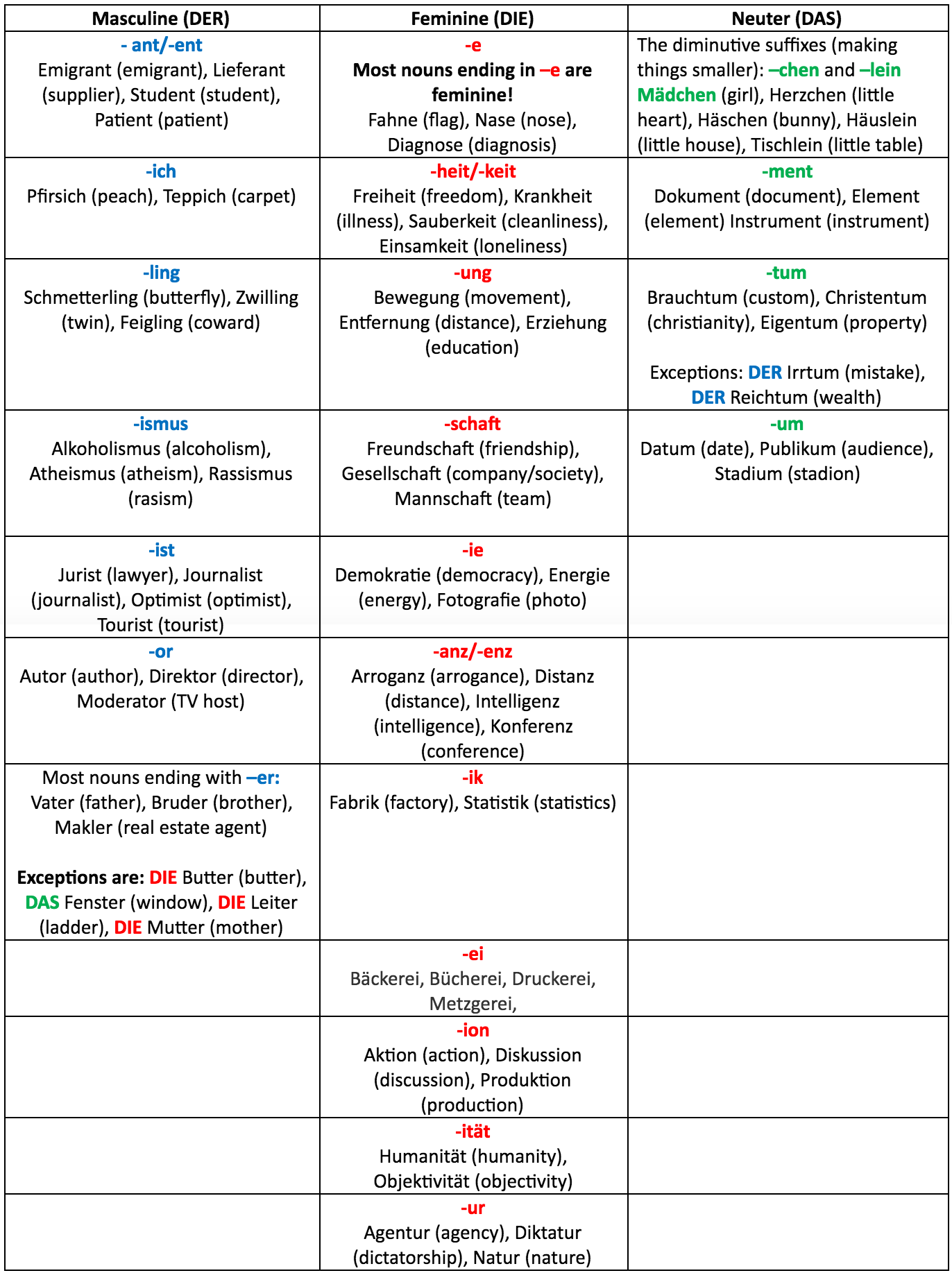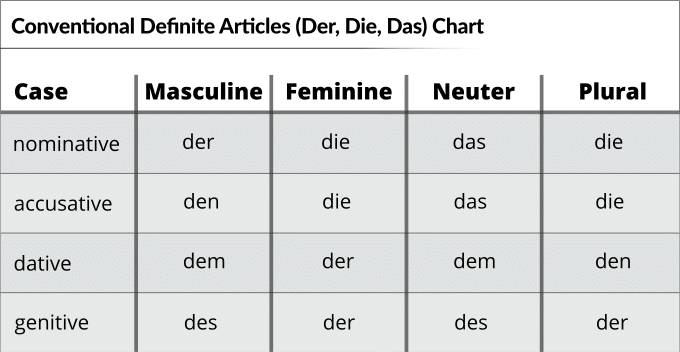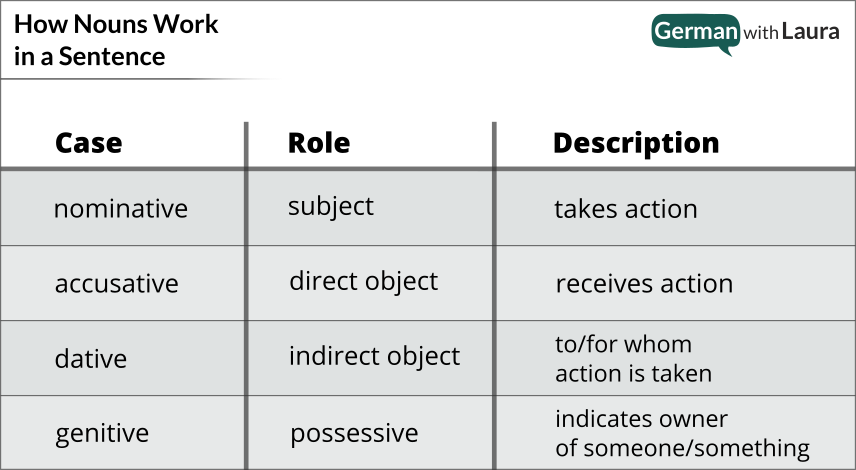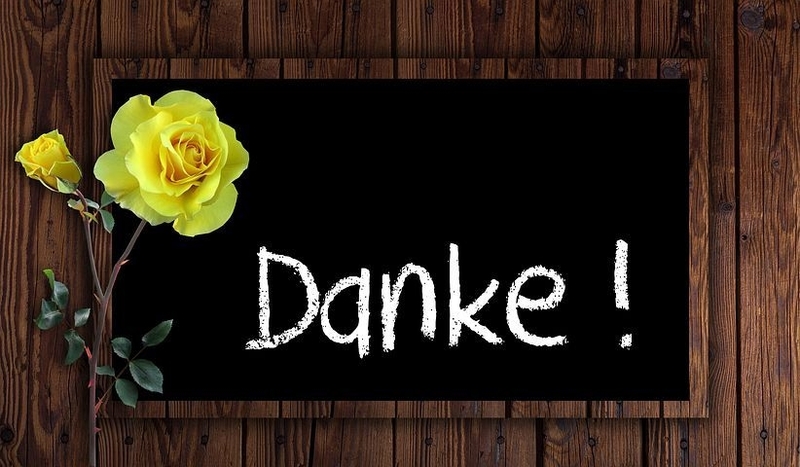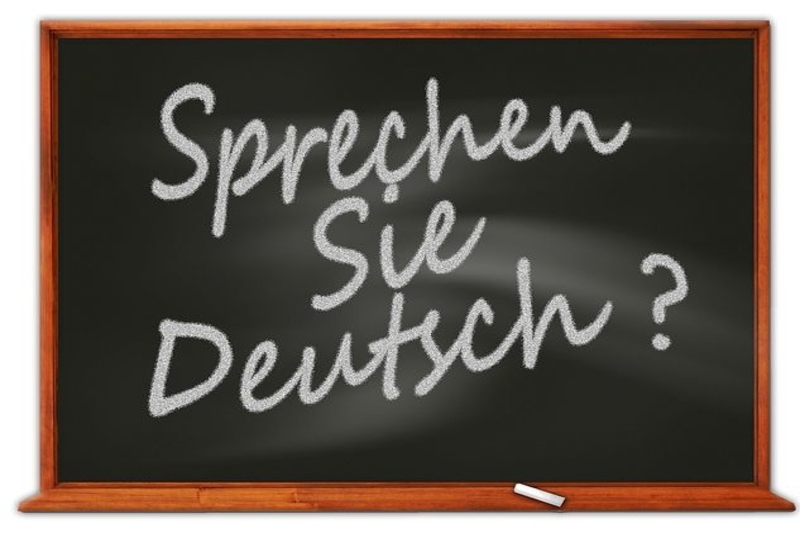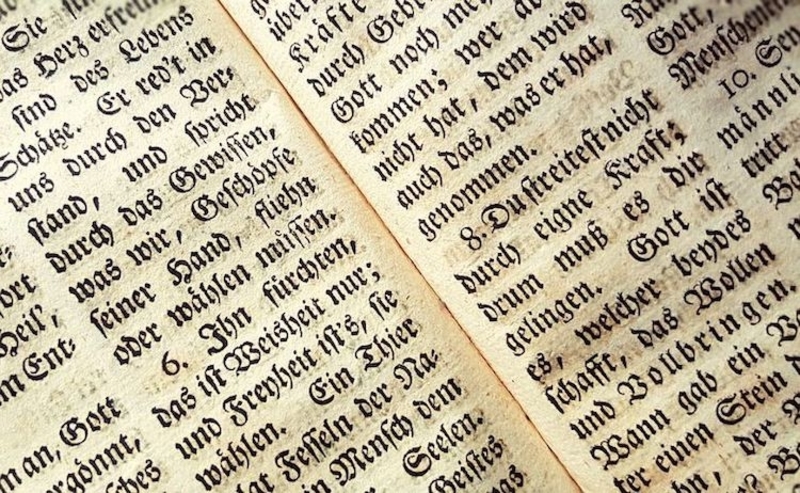In German we have three main articles (gender of nouns):
- der (masculine),
- die (feminine) and
- das (neuter)
Tip: The grammatical gender doesn’t follow a logical set of rules. So, always learn German nouns and articles together.
This page is about the 3 German articles. If you want to start even easier, visit the page where I explain the German alphabet.
- Listen: Examples with der die das
- Q/A Listening Exercise: German Articles
- How to find the correct German articles
- Der Die Das Quiz
1. Listen: Examples with der, die, das
How to learn with part A of the exercise
- Have a look at the picture.
- Read and listen a few times.
- Repeat after the speaker.
- Make sure that you imitate the pronunciation of the speaker.
- After a few repetitions go on to part B (farther below).
Tip: Always try to imagine the situations in your mind; it will help you to remember the words!
der Mann
the man
Der Mann liest.
The man is reading.
die Frau
the woman
Die Frau isst.
The woman is eating.
der Junge
the boy
Der Junge trinkt.
The boy is drinking.
das Mädchen*
the girl
Das Mädchen schreibt.
The girl is writing.
Note: *das Mädchen
Maybe you wonder why we don’t use the article die when we use the word Mädchen (girl). After all it is a female person, right?
Well, I know it is strange and I exaplain it here chen in German – Diminutive.
2. Q/A Listening Exercise: German Articles
How to learn with part B of the exercise
Question and Answer Part:
- Read and listen a few times to the questions and answers.
- Answer the questions in the pauses (you may look also at the answers).
- After a few times don’t look at the answers anymore.
- Make sure that you imitate the pronunciation of my voice.
- Repeat the lesson until you can answer the questions easily.
Question:
Wer liest – der Mann oder die Frau?
Who reads – the man or the woman?
Answer:
Der Mann
Der Mann liest.
The man reads. / The man is reading.
Wer isst – die Frau oder der Mann?
Who eats – the woman or the man?
Die Frau
Die Frau isst.
The woman eats. / The woman is eating.
Wer trinkt – das Mädchen oder der Junge?
Who drinks – the girl or the boy?
Der Junge
Der Junge trinkt.
The boy drinks. / The boy is drinking.
Und wer schreibt – die Frau oder das Mädchen?
And who writes – the woman or the girl?
Das Mädchen
Das Mädchen schreibt.
The girl writes. / The girl is writing.
You should also know what the German plural article is.
!
Repeat this lesson until you can easily answer the questions.
3. How to find the correct German articles
The best way to get familiar to the gender of the German articles is to listening a lot to the German language.
I don’t recommend learning words by heart but if you like to memorize words you should never learn just the nouns!
Always try to remember also the main articles der, die and das.
The grammatical gender in German doesn’t follow a logical set of rules but there are some noun endings (suffixes) which give us a hint.
However, be careful, it does not always work!
By the way, have a look at the English endings too. A lot of English and German words are similar.
German Nouns with Article: der (list)
-ling
der Häftling (the prisoner)
der Frühling (the spring)
der Flüchtling (the refugee)
der Säugling (the infant)
der Lehrling (the apprentice)
der Zwilling (the twin)
-ist
der Optimist (the optimist)
der Pianist (the pianist)
der Polizist (the policeman)
der Spezialist (the specialist)
-or
der Humor (the humor)
der Doktor (the doctor)
der Tresor (the safe)
der Professor (the professor)
der Motor (the motor)
-ismus
der Egoismus (the egoism)
der Tourismus (the tourism)
der Pazifismus (the pacifism)
-er
der Hörer (the receiver)
der Jäger (the hunter)
der Käfer (the bug, the beetle)
der Körper (the body)
der Tiger (the tiger)
der Bäcker (the baker)
der Donner (the thunder)
German Nouns with Article: die (list)
-keit
die Müdigkeit (the tiredness)
die Süßigkeit (the sweetness, the candy)
die Fähigkeit (the ability)
die Häufigkeit (the frequency)
die Flüssigkeit (the liquid, the fluid)
die Geschwindigkeit (the speed, the velocity)
die Fröhlichkeit (the joyfulness)
-ion
die Portion (the portion)
die Region (the region)
die Station (the station)
die Reaktion (the reaction)
die Situation (the situation)
die Nation (the nation)
die Tradition (the tradition)
-heit
die Feigheit (the cowardice)
die Schönheit (the beauty)
die Klugheit (the cleverness)
die Blödheit (the stupidity)
die Dummheit (the foolishness)
-enz
die Intelligenz (the intelligence)
die Konsequenz (the consequence)
die Frequenz (the frequency)
die Existenz (the existence)
die Differenz (the difference)
die Tendenz (the tendency)
-tät
die Normalität (the normality)
die Spezialität (the speciality)
die Elektrizität (the electricity)
die Flexibilität (the flexibility)
die Kontinuität (the continuity)
-ung
die Änderung (the change)
die Abteilung (the department)
die Einladung (the invitation)
die Anleitung (the instruction)
die Forschung (the research)
German Nouns with Article: das (list)
-nis
das Schulzeugnis (the school certificate)
das Gedächtnis (the memory)
das Erlebnis (the experience)
das Geheimnis (the secret)
das Hindernis (the obstacle)
-ment
das Dokument (the document)
das Sortiment (the assortment)
das Zement (the cement)
das Komplement (the complement)
das Medikament (the medication, the medicine)
das Instrument (the instrument)
4. Der Die Das Quiz – Click the start button
Take it now and see how good you are!
⬆️ Up here is the quiz!
Scroll up a little after pressing the start button to see the question.
If you want to dig deeper into the subject matter of the articles, have a look at Collins Dictionary. They also explain the German articles.
Happy Subscribers
%
Success rate after 6-8 months
German teacher with 14 years of experience
Share the knowledge …
… with your friends and classmates.
Use the social media buttons! 👍
When you first start learning German, you might feel quite upbeat and optimistic, thinking “Ok, this doesn’t look that hard, some of it is quite similar to English, like “Good morning” = “Guten Morgen” or “Monday” = “Montag”, I can do this!”.
What’s an article?
And then you come across a little something called ARTICLES (cue dramatic music). Since when are articles a problem? In English, life is easy; if you know what you want, you just use THE, and if you don’t know what you want, you use A/AN. It doesn’t matter if that thing you want is a specific chair, book or apartment. You will, without thinking twice, be able to say
“I want the chair with the fluffy pink unicorns on it.”
“I want the book that the cute guy with the blue shirt is reading.”
or
“I want the apartment with the stunning rooftop view.”
In English, you would use the same definite article “the” in all three sentences. In German, however, nouns (i.e. chair, book, apartment) have different grammatical genders. What’s this “grammatical gender” thing, you ask?
German nouns have a gender
In German, words that refer to things, i.e. nouns (both tangible, like “chair”, and abstract, like “freedom”) have a gender, either their natural, biological, gender (woman, man, daughter, son, etc.), or their grammatical gender, which means that the thing that the article refers to does not have a natural (biological) gender, but that the language assigned a gender to it nevertheless.
Therefore, in German, the words from the above example also have genders, even though they do not originate from the characteristics of the object, but are assigned somewhat randomly. In German “chair” is masculine (DER Stuhl), “book” is neuter (DAS Buch) and “apartment” is feminine (DIE Wohnung). The article DIE is also used to for the plural, irrespective of the singular gender, so
the chairs = DIE Stühle
the books = DIE Bücher
the apartments = DIE Wohnungen.
German definite articles table: der, die, das according to case and gender
Since German is a language that has cases, these articles change according to the grammatical case:
But, as you can see, there are similarities across genders and not all cases require different article forms. For example, the nominative/accusative cases for feminine and plural nouns are the same, and the same goes for the masculine and the neuter dative and genitive.
If you’re a German beginner, this table might seem quite daunting. But, apart from grouping the article forms according to their similarity, there is one other thing you can do to make your life easier – DROP THE GENITIVE CASE. That’s right; I just said you should ignore a whole case.
Ignore the genitive if you’re just starting out
Why? Because pretty soon the genitive case will no longer be with us. It will be pushing up the daisies and joining the choir invisible, like in the Monty Python’s Flying Circus “Dead Parrot” sketch.
There’s even a highly amusing book devoted to this topic, written by Bastian Sick and entitled “The Dative is to the Genitive its Death” (“Der Dativ ist dem Genitiv sein Tod”), which you should definitely have a look at once you can read books in German. What this title essentially means is that even native German speakers often use the dative instead of the genitive case and that pretty soon the genitive will cease to be used. Even now, the genitive is something you learn in German language courses only when you reach level B1 (intermediate user), or thereabouts. To sum up, you can have a pretty decent and grammatically correct conversation in German without ever using the genitive case.
When to use which article, der, die, or das?
After we have grouped our articles together according to their declension like in the table above and eliminated the genitive, life seems a bit easier. However, there is still the huge elephant in the room – how will you know when to use which article; DER, DIE or DAS?
For nouns that have a biological gender, this is easy.
Articles that follow the biological gender
- Masculine:
- der Mann (the man), der Schüler (the pupil), der Student (the student), der Herr (the sir)
- Feminine:
- die Frau (the woman), die Schülerin (the female pupil), die Studentin (the female student)
Occupations have both masculine and feminine forms. The feminine form is generally derived from the masculine by adding the ending “-in”, for example:
the teacher: der Lehrer / die Lehrerin
the boss: der Chef / die Chefin
the waiter: der Kellner / die Kellnerin
Some exceptions from the rule of “biological” gender are:
- the baby – das Baby
- the girl – das Mädchen
- the child – das Kind
Yes, you read that correctly – “the girl” in German is grammatically not feminine, but neuter (das Mädchen). You will find the reasoning behind this seemingly senseless and illogical feature of the German language in the following section.
Nouns with a grammatical gender
Unfortunately, the majority of nouns in German do not have a naturally occurring biological gender. But this doesn’t mean that you have to curl up in a ball in the corner of the room and cry. You do not have to learn ALL the genders of ALL the nouns by heart – there are shortcuts.
You can use the noun endings (also called suffixes) to solve approximately 50% of your article and noun gender-related problems. Simply learn which noun endings indicate which gender and you will know which article to use. That easy!
The following table shows some of the suffixes that indicate a specific gender.
German definite articles chart: suffixes that indicate gender
Although this table is not exhaustive or to be taken as 100% correct all of the time, it will work for you 9 out of 10 times for basically half the nouns in the German language. In my book, that’s worth a lot! So the next time you see a new word and it ends in, for example, –ung, -schaft, or –heit/-keit you already know that it’s gender is feminine. Or if something ends in –lein or –chen you know it’s a diminutive and therefore a neuter. Pretty cool, right?
Gender according to certain categories of meaning
One last shortcut to help you with your noun genders and articles is to learn certain categories of meaning that are always the same gender, such as the following.
Masculine:
- times of day, time of the year, months and days of the week (Morgen, Mittag, Abend, Frühling, Sommer, Januar, Februar, Montag, Dienstag…); Exceptions: DIE Nacht (night), DIE Mitternacht (midnight)
- directions: Süden (south), Norden (north), Osten (east), Westen (west), Südwesten (southwest)…
- weather-related words: Hurrikan (hurricane), Monsun (monsoon), Regen (rain), Schnee (snow), Wind (wind); Exceptions: DAS Eis (ice), DIE Kälte (the cold), DIE Hitze (heat), DIE Wolke (cloud) [But then, for Kälte, Hitze and Wolke you already know that they’re feminine, because they end in –e, right? ☺]
- alcoholic beverages: Cognac, Rum, Wein (wine); Exception: DAS Bier (beer)
- car brands: Audi, Fiat, Ford…
Feminine:
- motorcycle brands: Honda, Kawasaki, Yamaha…
- names of ships: Titanic, Queen Elizabeth…
- names of cigarettes: Camel, Marlboro
- numbers used as nouns: die Zwei, die Hundert, die Million…
Neuter:
- names of colours: Blau, Rosarot, Schneeweiß…
- nouns that originate from verbs: Essen (eating), Lernen (learning), Reisen (travelling)…
So, to sum up, here is your ultimate survival kit for German articles/noun genders in one place:
- Eliminate the genitive case from the declension table (well, at least for now)
- Group the declensions of the definite article for the remaining three cases according to their similarity (check out the color-coded table I used before)
- Try to remember some (or all) of the noun endings that indicate gender, this will help you recognize the gender of almost half the nouns in the German language!
- Have a look at the different categories of words that are always the same gender
And last, but not least:
- Whenever you learn a new word in German, learn its gender at the same time! This will make life so much easier for you later on. For instance, if you learn the German word for book, which is Buch, always learn and repeat it by including its article, e.g. when studying or taking notes on new vocabulary always say das Buch instead of just Buch.
Ideally, at this point you would also learn its plural form (since it is often irregular), like this:
das Buch – die Bücher
Finally, as someone who has been speaking German all their life and teaching it for 10 years, I would like to offer the following little nugget of wisdom with regard to German articles – don’t worry about them too much. It’s ok to learn their declension, the noun suffixes, etc., I stand by all of the advice I have given in this article. But even if you work really, really hard, study all the cases and endings, always write down the article when learning a new word, you will inevitably make mistakes. Learning a language is all about making mistakes. In fact, I would dare say that it’s much more important to make lots and lots of mistakes, have someone correct you and then learn from these mistakes, than to try to avoid them by not speaking at all. What’s important is to embrace this aspect of language learning and to not get frustrated about making the same mistake a million times.
What’s the best way to learn definite articles in German?
The best you can do to improve your language skills is take the German you know now, at this very moment, and go out into the world (or some online language learning community, for example) and USE IT. It won’t be perfect, it will be chaotic and messy, everything you thought you knew will just disappear and you will find yourself sounding like a complete beginner. And that’s perfectly ok! What’s most important when using a new language is simply being able to establish communication with another person. If you can’t communicate in a language, then you don’t really speak it, do you? And using the wrong article will generally not interfere with your communication or the message you are trying to convey. So, if I were somewhere in Germany, going for a leisurely walk in a historic town, and heard someone scream out
Hilfe! *Die Mädchen hat mir mein Handy gestohlen. (Help! The girl stole my mobile phone.)
I wouldn’t go into walk up to this person and say “Entschuldigung, meinten Sie nicht DAS Mädchen?” – “Excuse me, I believe you meant DAS Mädchen?” (although I might bring this up once the crisis was resolved ☺). No, I would go and try to help this person. It didn’t matter that they used the feminine article instead of the neuter, I could still understand what they were trying to say. That’s what I always emphasize with my students, that they shouldn’t make a fuss when they accidentally used the wrong article because I was still able to understand perfectly well what they were trying to say. And as long as I can do that, they are doing awesome.
Exposure and practice are key
Like with anything in life, learning articles takes a lot of patience and time. There are no quick fixes and it will not come to you overnight, but gradually and with experience. The more you expose yourself to the German language, the easier it will be for you. The best thing you can do is to immerse yourself as much as possible in the German language and culture – to listen to lots of German music, watch German TV shows (there are lots of options for free online) and just try to use it as often as you can. Clozemaster is great for this type of immersion. Whether you play the Grammar Challenge or just the Fast Track, you’ll get plenty of exposure to how German definite articles are used in context. The most successful language learners know that learning to speak a language isn’t about memorizing lots of tables by heart, but about having fun with it. So go out there, have some fun with German, and definite articles will follow suit.
Check out the German definite articles Grammar Challenge on Clozemaster – practice choosing and declining the correct definite article for thousands sentences in German!

One of the first questions you might have about learning German is how to say German articles, “the” , “a” and “an”.
But, the choices are a little more complicated in German. Instead of two options, you have 11: der, die, das, den, dem, des, ein, eine, einen, einem, and eines.
However, you shouldn’t let these articles intimidate you. Because there are plenty of guidelines that can help you choose right.
Like most other aspects of the German language, there are several systematic ways to learn the different articles. And you’re going to discover them in this post!
By the way, if you want to learn German fast and have fun, my top recommendation is German Uncovered which teaches you through StoryLearning®.
If you’re ready to get started, click here for a 7-day FREE trial.
What Are Articles?
So articles are words like “a,” “an,” and “the”. These short articles precede nouns that can be people, places, or things.
Articles are simple in English. However, in German, you have over a dozen article options to choose from!
How To Pick The Right Article Declension
Fortunately, German articles can tell you a lot more information about a sentence. And there are many effective ways of remembering which one to use when.
For example, German articles can reveal more about the noun:
- Number – Articles in German can tell you if a noun is singular or plural.
- Gender – German articles indicate the gender of the noun they precede.
- Case – You can also tell which words are the subject, direct object, and indirect object. Using the right articles, you’ll have the flexibility to change the word order without changing the meaning! In English, we don’t have this luxury. Because we have to stick to a specific sentence structure to make sense.
So this guide will teach you how to use German articles correctly and boost your fluency.
Definite vs. Indefinite Articles In German
There are two general categories of articles:
- Definite Articles – In English, we use the word “the” to talk about a specific person, idea, or object. The three main definite articles in German are der, die, and das.
- Indefinite Articles – The words “a” and “an” allow us to speak about more generic people, places, or objects. In German, words like ein and eine are the equivalent.
Using the right definite and indefinite articles in German is often considered one of the most challenging aspects of learning the language.
But, all you really need is patience, practice. And the willingness to learn.
The German Definite Articles
In German, definite articles change according to their gender, case, and number. But we’ll dive deeper into how to determine the gender of nouns and assign the correct articles later.
For now, let’s see what the options are:
| Case/Gender | Masculine | Feminine | Neuter | Plural |
| Nominative | der | die | das | die |
| Accusative | den | die | das | die |
| Dative | dem | der | dem | den |
Above, you’ll see the three primary definite articles der, die, and das. The word “die” is also used in the plural form. In addition to gender, definite articles also have a case: nominative, accusative, or dative. If you haven’t already, learn more about The German Case System.
So let’s look at a few simple examples of definite articles in sentences:
- Der Mann heißt Heinrich. (The man is named Heinrich.)
- Die Frau liest mir das Buch. (The woman reads the book to me.)
- Das Kind gibt dem Lehrer den Apfel. (The child gives the teacher the apple.)
Next, let’s look at what happens to adjectives used between definite articles and their nouns.
Definite Article Adjective Endings
In addition, if you want to add an adjective between the definite article and a noun, you’ll need to add an appropriate German adjective ending.
| Adjective Endings | Masculine | Feminine | Neuter | Plural |
| Nominative | -e | -e | -e | -en |
| Accusative | -en | -e | -e | -en |
| Dative | -en | -en | -en | -en |
In the table above, you’ll see the adjective ending is always ‘e’ for feminine and neuter nouns in the nominative and accusative cases.
The plural ending for adjectives following definite articles is ‘en’. But masculine words have an ‘e’ ending in the nominative case. And an ‘en’ ending in the accusative and dative cases.
Next let’s add some adjectives to the previous example sentences so we can see how adjective endings work:
- Der kleine Mann heißt Heinrich. (The small man is named Heinrich.)
- Die nette Frau liest mir das Buch. (The nice woman reads the book to me.)
- Das kleine Kind gibt dem neuen Lehrer den frischen Apfel. (The young child gives the new teacher the fresh apple.)
In the first example, der Mann is masculine. And the subject uses the nominative with an e ending. In the next example, die Frau is a feminine noun in the nominative case, which is why you need an ‘e’ ending once again.
Similarly, das Kind is a neuter noun in the nominative. And also takes an ‘e’ ending. Dem Lehrer is the indirect object receiving an object, which takes the dative case and an en ending. Den Apfel is the direct object, which takes the accusative case and an en ending.
The German Indefinite Articles
Similarly, indefinite German articles also change according to gender and case.
| Case/Gender | Masculine | Feminine | Neuter |
| Nominative | ein | eine | ein |
| Accusative | einen | eine | ein |
| Dative | einem | einer | einem |
So let’s plug those indefinite articles into sentences:
- Ich sehe einen Mann. (I see a man.)
- Wir treffen eine Frau. (We are meeting a woman.)
- Er hat ein Kind. (He has a child.)
All of the examples above are in the accusative case. However, each noun takes the form that corresponds to its gender.
Indefinite Article Adjective Endings
In a similar vein to definite articles, if you want to use an adjective after an article and before the noun, the adjective will need an ending.
| Adjective Endings | Masculine | Feminine | Neuter |
| Nominative | -er | -e | -es |
| Accusative | -en | -e | -es |
| Dative | -en | -en | -en |
Notice that the feminine and neuter forms don’t change in the nominative or accusative, only in the dative case. But masculine articles change the most.
- Ich sehe einen alten Mann. (I see an old man.)
- Wir treffen eine reiche Frau in einem hohen Schloss. (We are meeting a rich woman in a tall castle.)
- Er hat ein zweites Kind mit einer anderen Frau. (He has a second child with another woman.)
In the first sentence, einen Mann is in the accusative case. And our adjective alt (old) takes an en ending. Next, eine Frau, also in the accusative case, requires an ‘e’ ending for its adjective reich (rich). Finally, both the second and third examples end with prepositional phrases in the dative case.
German Articles Have Genders
All German nouns have one of three genders: masculine, feminine, and neuter, and require the corresponding articles.
But, how can you learn which words have which gender?
While some noun genders have to be memorized, you can identify others by various letter combinations.
Firstly, some German noun genders are biologically determined.
- Masculine – Der Mann (the man), der Vater (the father), der Student (the male student), der Lehrer (the male teacher), der Mitarbeiter (the male employee), etc.
- Feminine – Die Frau (the woman), die Mutter (the mother), die Studentin (the female student), die Lehrerin (the female teacher), die Mitarbeiterin (the female employee), etc.
- Neuter – Das Baby (the baby), das Kind (the child), das Haus (the house)
Secondly, most occupational names have both masculine and feminine versions, depending on the gender of the person. In contrast, other German nouns follow grammatical gender patterns.
Note that in English, we refer to objects as “it.” But in German, you use a pronoun that corresponds with the noun’s gender, er, sie, or es.
How To Know The Gender Of German Articles
Although not all German nouns follow a gender rule, some letter combinations and other guidelines can help you choose the right gender 9 times out of 10.
- Firstly, over 65% of one-syllable words in German are masculine.
- Secondly, some suffixes are almost always masculine, like ant, er, and or.
- Thirdly, endings such as heit, keit, and ung are feminine.
- And finally neuter endings include chen, lein, um, and o.
So, when you learn new German words, you also need to learn the gender. Then, you’ll need the gender to add the right endings to several other words in a sentence. Luckily, there are specific clues that often indicate a noun’s gender.
Now, let’s look at these hints in more detail to decide whether we need to use der, die, or das.
Masculine Nouns And The Article der
Firstly, below are the suffixes that tend to indicate the masculine gender (der):
- ant – Diamant (diamond), Elefant (elephant), Praktikant (intern)
- ent – Student (student), Patient (patient), Assistent (assistant), Dozent (professor)
- er – Fahrer (driver), Maler (painter), Spieler (player)
- ich – Teppich (carpet), Rettich (radish)
- ismus – Kapitalismus (capitalism), Tourismus (tourism), Alkoholismus (alcoholism)
- ist – Kapitalist (capitalist), Tourist (tourist), Kommunist (communist)
- ling – Zwilling (twin), Frühling (spring)
- or – Autor (author), Diktator (dictator),
In addition, other masculine nouns include:
- Seasons – der Sommer (the summer), der Herbst (the fall), der Winter (the winter)
- Months – der Januar (January), der Februar (February), der März (March)
- Days – der Montag (Monday), der Dienstag (Tuesday), der Mittwoch (Wednesday)
- Map and compass directions – der Norden (north), der Suden (south), der Westen (west), der Osten (east)
- Cars and trains – der BMW, der Volkswagen, der Mercedes
- Many currencies – der Euro, der Dollar, der Cent
- Most mountains or lakes – der Mount Everest, der Mississippi, der Montblanc
Learning the categories and typical endings of words that tend to have a specific noun gender can make the learning process much more manageable.
Also, German occupations can have either a masculine or feminine form. The masculine form usually ends in er or or.
Examples: der Lehrer (the male teacher), der Professor (the male professor), der Fotograf (the male photographer), der Kellner (the male waiter)
Feminine Nouns And The Article die
Secondly, below are the tell-tale suffixes of feminine nouns (die):
- e – Blume (flower), Summe (sum), Katze (cat)
- ei – Polizei (police), Datei (data), Konditorei (confectionary)
- heit – Freiheit (freedom), Gesundheit (health), Sicherheit (security)
- ie – Garantie (guarantee), Fantasie (fantasy), Ökonomie (economy)
- ik – Grammatik (grammar), Mathematik (math), Musik (music)
- ion – Nation (nation), Funktion (function), Produktion (production)
- ität – Nationalität (nationality), Autorität (authority), Spontaneität (sponteneity)
- keit – Aufmerksamkeit (attention), Schwierigkeit (difficulty)
- schaft – Freundschaft (friendship), Landschaft (landscape), Gemeinschaft (community)
- ung – Erfahrung (experience), Empfehlung (recommendation), Zeitung (newspaper)
- ur – Natur (nature), Kultur (culture), Agentur (agency)
Other feminine nouns also include:
- Names of flowers – die Rose (rose), die Tulpe (tulip)
- Names of trees – die Kiefer (pine), die Buche (beech), die Eiche (oak)
- Most fruits – die Birne (pear), die Zitrone (lemon), die Melone (melon)
- Cardinal numbers – die Eins (one), die Zwei (two), die Drei (three)
In addition, feminine occupations add the ending –in.
Examples: die Lehrerin (the female teacher), die Professorin (the female professor), die Fotografin (the female photographer), die Kellnerin (the waitress)
Neuter Nouns And The Article das
Finally, the endings below usually indicate neuter (das) nouns.
- chen – Mädchen (girl), Häuschen (little house),
- lein – Häuslein (little house), Mäuslein (little mouse), Fräulein (young woman)
- ma – Thema (topic), Drama (drama), Schema (diagram)
- ment – Moment (moment), Dokument (document), Experiment (experiment)
- nis – Geheimnis (secret), Gefängnis (jail), Kenntnis (knowledge)
- tel – Hotel (hotel), Viertel (quarter)
- tum – Eigentum (property), Königtum (kingdom), Christentum (christianity)
- um – Aquarium (aquarium), Museum (museum)
However, it’s important to note that there are exceptions to the rules.
Examples: die Firma (company), der Reichtum (wealth), der Irrtum (mistake), der Zement (cement)
Compound Noun Genders
In addition, many words in German combine multiple nouns into a new word.
For example:
- die Baustelle (construction site)
- der Fahrplan (the timetable)
- das Kinderbuch (children’s book)
In most cases, the last word of the compound noun determines the gender. But, as usual, there are a few exceptions to the rule.
- der Teil (part) – Some compound nouns with Teil take neuter articles: das Gegenteil (opposite), das Einzelteil (individual part), das Abteil (compartment), das Oberteil (top piece), das Ersatzteil (replacement part), das Urteil (verdict).
- der Mut (courage) – Many compound nouns containing Mut take feminine articles: die Armut (poverty), die Wehmut (sorrow), die Demut (humility), die Anmut (grace), die Großmut (generosity), die Langmut (patience).
Also, there are many other exceptions to the noun gender rules. But using the guidelines when in doubt will work 80% of the time.
Plural German Articles
Let’s take a moment next to understand how plural articles work in German. Plural nouns always use the article die in the nominative and accusative cases.
- das Mädchen (the girl) – die Mädchen (the girls)
- der Junge (the boy) – die Jungs/Jungen (the boys)
- der Mann (the man) – die Männer (the men)
But in the dative plural case, die changes to den.
- Ich gab den Mädchen Hausaufgaben. (I gave the girls homework.)
- Wir waren überrascht, von den Jungs zu hören. (We were surprised to hear from the boys.)
- Er war beeindruckt von den Männern und ihrer Arbeit.
When declining adjectives, definite articles’ plural ending is ‘en’ in the nominative, accusative, and dative cases.
- die amerikanischen Mädchen (the American girls)
- Ich gab den faulen Mädchen Hausaufgaben. (I gave the lazy girls homework.)
Another reason to learn the genders of German words is to know if a noun is in its plural or singular form.
For example, the noun Mädchen (girl) is the same in both the singular and plural. So the only way to determine the sentence’s meaning is by examining the articles.
How Case Affects German Articles
To choose the right article declension, you’ll need to know the number, case, and gender. So you already learned how number and gender affect articles. But what about the cases?
So let’s look at German articles from a slightly different angle to see how they change according to the case.
The Nominative Case
Firstly, the nominative case is used for the subject of a sentence. Notice how the feminine and plural articles are the same.
| Definite/Indefinite Articles | Masculine | Feminine | Neuter | Plural |
| Nominative | der/ein | die/eine | das/ein | die/keine |
For example:
- Der/Ein Student lernt schnell. (The/A student learns fast.)
- Die/Eine Blume ist rot. (The/A flower is red.)
- Das/Ein Thema ist langweilig. (The/A topic is boring.)
All of the sentence subjects above use the nominative case of definite and indefinite articles.
The Accusative Case
Secondly, choose accusative case articles for the direct objects of sentences. The direct object of a sentence is the word receiving an action from the verb.
| Definite/Indefinite Articles | Masculine | Feminine | Neuter | Plural |
| Accusative | den/einen | die/eine | das/ein | die/keine |
Notice that neuter and feminine nouns have the same articles in both the nominative, accusative, and plural. So far, only the masculine form changes: der becomes den and ein becomes einen.
Examples:
- Ich (nominative) kaufe den/einen Tisch (accusative). (I buy the/a table.)
- Ein Fahrer (nominative) liefert die/eine Zeitung (accusative). (A driver delivers the/a newspaper.)
- Meine Mutter (nominative) liest das/ein Buch (accusative). (My mother reads the/a book.)
The Dative Case
Thirdly, in the dative case, the most drastic changes take place. Use the dative for indirect objects of a sentence. Indirect objects are typically the person or thing being affected by the direct object.
| Definite/Indefinite Articles | Masculine | Feminine | Neuter | Plural |
| Dative | dem/einem | der/einer | dem/einem | den/keinen |
Because the masculine and neuter articles are the same in the dative case, they’re easier to remember. Meanwhile, the feminine articles change into what appears to be the masculine nominative form.
Examples:
- Der Mann (nominative masculine) gibt den Anzug (accusative masculine) der Reinigung (dative feminine). (The man gives the suit to the dry cleaner.)
- Die Professorin (nominative feminine) gibt dem Student (dative masculine) das Buch (accusative neuter). (The professor gives the student the book.)
Now comes the exciting part. German allows you to mix up the word order, as long as you use the correct articles to indicate the direct and indirect objects.
- Der Mann (nominative masculine) gibt der Reinigung (dative feminine) den Anzug (accusative masculine). (The man gives the suit to the dry cleaner.)
- Die Professorin (nominative feminine) gibt das Buch (accusative neuter) dem Student (dative masculine). (The professor gives the student the book.)
Although the subject typically stays in the first position, you can place the direct and indirect object in either position in the sentence.
Possessive Articles
In English, we show possession by adding an ‘s to a name or person. But, to indicate that something belongs to someone in German, you’ll need possessive articles. You’ll also need an ‘s‘ or ‘es’ ending on the noun’s end in the masculine and neuter forms.
| Definite/Indefinite Articles | Masculine | Feminine | Neuter | Plural |
| Possessive | des/eines | der/einer | des/eines | der/keiner |
Once again, the masculine and neuter forms are the same, just as they are in the dative case.
Examples:
- das Fahrrad des Mannes (The man’s bicycle)
- die Jacke der Frau. (The woman’s jacket)
- das Geheimnis des Hotels. (The hotel’s secret.)
Usually, masculine and neuter, one-syllable words add an ‘es’ ending while multiple-syllable words add an s ending.
How To Learn German Articles
Below are a few study tips to help you learn the German articles more effectively:
- Firstly, learn nouns and their genders together.
- Secondly, neuter, feminine, and plural articles stay the same in the nominative and accusative cases.
- Thirdly, masculine and neuter, definite and indefinite articles are the same in the dative and possessive cases.
- Finally, the feminine indefinite articles are the same in the dative and possessive cases.
Although learning the German articles does require some memorization of charts, the similarities are simple to recognize.
By creating connections between the articles and their use, you’ll learn to select the correct articles with ease.
Final Thoughts
So now you’ve started to master German articles, it’s time to put them into use! Practice makes perfect when it comes to article declensions.
So consider watching German movies or TV series with subtitles to become more familiar with articles.
In addition, reading in German is another fantastic way to start feeling more comfortable with the articles and the general language.
Now, you’re all set to speak German with more confidence and accuracy than ever before.
Bis zum nächsten mal! (Until next time)
The charts and images used on this website are copyright protected.
Sharing or using these images in public or commercially is prohibited.
Contact me for commercial use (e.g. teaching).
(If you would like to share, share this webpage).
If you’re searching for info on German articles, it means two things:
- You’re serious about learning German
- You’ve hit the same roadblock that every German student does!
German would be a heckuva lot easier to learn if we didn’t have to worry about tricky little topics such as articles, am I right?
But we couldn’t say anything without the words the and a, for example. So articles are a must!
The good news is that there is an efficient, effective way to learn all these German articles. It doesn’t have to be tedious, overwhelming, or even very time-consuming. Intrigued?
You’ll learn the following:
- all types of German articles
- how to use articles in sentences
- why conventional teaching of articles is all wrong
- how to avoid using 10 different articles charts!
- the declensions all articles need
- a better term than articles (sneakpeek: determiners)
- and more!
What You Need To Know
German is classified as a different type of language from English: German is an inflected language and English is an analytic language.
Part of that difference means that, in German, we must learn slightly different ways to say the same words — for example, different articles!
Articles are little (but important) words such as ‘the’ and ‘a’.
There are six slightly different ways to say each of them in German.
I know that can be hard to compute for us English speakers. We have just the and a/an.
That’s 3 English options to 12 German ones. So, we’ve got some work to do! 😊
What Are Articles?
Ooh. Tough question! The true (but unsatisfying) answer is that there can be a lot of overlapping vocabulary here. So, if you’re feeling confused, you’re not alone!
Generally speaking, what we can say for sure is that the categorization “articles” will always refer to definite articles (the 6 ways of saying ‘the’ in German) and to indefinite articles (the 6 ways of saying ‘a’ in German).
Beyond that, the waters get murky. Some people use the same term ‘articles’ to refer to other words come in front of nouns (e.g. this, that, some, all, etc.).
But you’ll also see the terms determiners, pronouns, and even adjectives coming up in discussion, with all the lines of definition between them very frustratingly blurred.
Personally, I advocate for ditching the term articles altogether (read more below!). Instead, I refer to determiners AND pronouns AND adjectives all as very clearly different types of words.
More on these useful distinctions in a bit!
Definite articles (der, die, das, etc.)
When a German learner looks for ‘articles’, one of the first things you’ll be introduced to is a chart like this:
Or maybe this somewhat improved version:
Either way, we have a chart that tells us specifically how to say ’the’ in German — six different ways!
How do you pick out the correct variant of ‘the’?
In order to pick out the version of the that you need, you have to know two things:
- What is the gender of the noun?
- What is the case of the noun?
For example, if you want to say the book in German, you have to know that book (Buch) is a neuter noun. Not masculine or feminine (and plural would obviously be books, and that’s different).
With this much information, you know that you need the das, dem, or des version of the neuter ‘the’.
Figuring out which case Buch needs to be in is the 2nd step that then whittles these three options ^^ down to just one!
I walk you through determining noun case in the Digging Deeper section below.
Indefinite articles (ein, eine, einen, etc.)
It’s all well-and-good to learn how to say the in German. And maybe you’re thinking that one chart wasn’t so bad.
But there’s more!
Now you have to learn how to say a (and ‘not a/any’) in German, which is also obviously pretty important.
Of course, in conventional German-learning, there’s another chart for that:
Here you have the same uber-traditional version and a somewhat improved, more ‘modern’ version of the chart. But it’s a lot of tedious memorization either way.
And, of course, just as with the definite articles, you still have to learn how to know the gender and case of every noun in order to actually use the charts. Yikes.
Demonstratives (der-words)
At this point, you might already be feeling a bit overwhelmed. But we’ve barely even gotten started!
Now you need to learn about a 3rd type of articles called demonstratives or der-words, which are words such as every, this, that, many, etc. as in every mouse, this cat, that dog, many snakes.
Most common der-words:
all- (all)
welch- (which)
dies- (this)
jed- (every),
jen- (that)
einig- (some)
wenig- (few)
manch- (many a, some)
solch(-) (such [a])
and all other determiners!
TIP: if the determiner is not an ein-word (<— defined later), it’s a der-word by default.
Der-word declensions
Hang on, now! What are declensions?
You’ve already seen them in the definite article and indefinite article charts. But here’s a definition for you:
Declensions are endings that get put onto words (including, but not limited to, articles) so that they reflect the gender & case of the noun the follows.
Der-words all take what are called strong declensions <– rather implies that there’s at least one other type of declensions … possibly weak declensions. 😉
For example, if you want to talk about this book (‘this’ is a der-word), you’d have these options:
nominative: dieses Buch
accusative: dieses Buch
dative: diesem Buch
genitive: dieses Buchs
NERD ALERT: Demonstratives are also called der-words (<— a term we will continue to use!) because of the similarities of these strong declensions (that der-words use) to the different ways of saying ‘the’. Hint: it’s all about the very last letter (regardless of what different vowels might precede it!).
Possessives
If you’re thinking that this topic of articles is getting progressively harder, you’re right — it sure is.
When it comes to possessives, we have a two-fold problem:
- There are two different types (keep reading)
- There are inconsistent labeling systems (pronouns? adjectives? determiners? articles?)
Possessives indicate possession, of course, as in that’s MY book.
But, we can also say that book is MINE.
My and mine. What is the deal with that?
- The one type — my — comes in front of a noun.
- The other type — mine — stands by itself, not in front of a noun.
German has the same two types! And YES, there are different charts for that.
You start with the same ‘root’ word, for example: mein (my/mine).
‘Root’ Form of Possessives
mein- (my/mine)
dein- (your/yours)
sein- (his)
ihr- (her/hers, also their/theirs, also Your/Yours [formal]) → I know! Yikes!
unser- (our/ours)
euer/eur- (y’all, y’alls)
But if you want the ‘my’ version, you need to use the declensions (or endings) from this chart, which is for ein-words (vs. der-words –more on this soon!):
If you want the mine version, you’d use the same strong declensions chart from the demonstratives above, or maybe you’d see it all spelled out like this:
If all these charts (and these are just some of them!!!) aren’t making you feel even the slightest bit burnt out on German, that amazes me. I speak German fluently (and so don’t need to use any charts anymore), but just talking about all of this makes my head ache.
Articles, the smarter way
Traditionally — as you’ve gotten a taste for above! — German students are introduced to lots and lots of separate charts for all the various words that come in front of nouns.
Not only would you have those 4 (or 5) charts from above thrown at you, but you’d also have to worry about these charts:
Relative/Demonstrative Pronouns
Possessive Pronouns
Indefinite Pronouns
Strong Adjectives, No Determiner
Weak Adjectives (With Determiner)
Mixed Adjectives (with ein-word Determiners)
That’s a total of 10 charts with just itty bitty changes that somehow you have to remember.
At this point, you might be thinking that German SUCKS.
The good news is that all these charts have much more in common than not.
That means that it’s possible to combine them all, redefine / recategorize some terms (keep reading!) and mention a handful of special exceptions (also coming up!).
The simplified All-In-One Chart you’ll discover below covers all our bases and gives you a solid foundation in German that doesn’t involve tons of mind-numbing, overwhelming, unnecessary charts.
Now, THAT sounds like something I can get behind!
Der-words & Ein-words Charts, Compared
So you can see what I mean about all the separate charts having more in common than not, compare the der-word (a.k.a. strong declensions) chart & chart for ein-words (<– NOT the weak declensions chart … that’s something else and we’ll talk about it later).
Can you see the similarities and differences?
That’s it! Except for in 3 spots, they are exactly the same.
The spots where the declensions are different are:
- masculine nominative
- neuter nominative
- neuter accusative
Now, look back at the definite article chart and the two possessives charts and you’ll see that they line up the same way! All those declensions are the same except for just the same three spots.
So, now the golden question: if there are just THREE exception spots (<–out of 16, not bad!), why on earth do we have to study so many different charts?
I thought you’d never ask. That’s exactly it! YOU DON’T.
ALL of those 10 charts (including the 3 on adjectives that I cover here and the charts on pronouns here) fit together nicely with primarily overlapping material.
All-In-One Chart combines both charts (and MORE)!
Now, look again at the der-words and ein-words charts with this new All-In-One Chart underneath them for easy reference.
The All-In-One Chart overlays them both!
All of the declensions that are shared in common are listed under for strong declensions.
What about our 3 exception spots? Those are taken care of, too!
There is a listed in the same three exception spots where the indefinite & possessives article charts are not identical to the definite & demonstrative articles:
- masculine nominative
- neuter nominative
- neuter accusative
In these three spots, the indefinite article, the possessives, and a couple other words don’t take declensions. More on that soon!
How exactly to read & use the All-In-One Chart will be covered in depth below. Keep reading!
Digging Deeper
In this section, you will learn how to master declensions with the All-In-One Declensions Chart including learning about:
- how to determine noun gender
- how to determine noun case
- basic declensions patterns
- types of words that need declensions
- der-words vs. ein-words
- types of declensions
You’ll also learn why you can forget about articles and what terminology / concept to focus on instead! Let’s start there.
Forget About Articles
In order to properly use the All-In-One Declensions Chart, you need to forget all about the different charts for definite and indefinite articles, demonstratives, and possessives!!!
Remember instead that all of these words are simply determiners (that, of course, each have their own distinct meanings of the, a, this, my, etc.).
Determiners is a big, overarching category that includes all the different types of ‘articles’ plus a bunch of other words (e.g. pronouns) that all take the same declensions in the same way (even if their function within the sentence is different, as in the case between determiners & pronouns).
Determiners are all sorts of little words — like some, many, a few, every, not any, this, and that — that tell us how many or which one as in ‘many apples’ or ‘this apple’.
ALL determiners are split into JUST two groups: ein-words & der-words (<– you’ll find out why this is an important distinction soon)!
EIN-words:ein (a), irgendein (any), kein (not a / any), and all possessives (mein, dein, etc.)
DER-words: der/die/das (the), welch- (which), dies- (this), jed- (every), jen- (that), einig- (some), wenig- (few) and all other determiners!
TIP: if the determiner is not an ein-word, it’s a der-word by default.
All determiners — because they come in front of nouns as part of the noun phrase — need to have declensions. The only other type of word that needs declensions are adjectives, covered separately.
Types of Declensions
Instead of stressing out over many types of kinda-different, kinda-the-same declensions, when we cleverly combine it all, there are actually only two types of declensions:
- Strong declensions better (but not flawlessly) indicate the gender/case of the noun because they are the most varied.
- Weak declensions do not indicate the gender/case of the noun because they have almost no variation (there are just two options: -e or -en).
You’ve already seen an example of the conventional strong declensions chart:
And the conventional weak declensions(and also a mixed declensions chart, that is part-strong, part-weak) applies only to adjectives, not determiners.
Using the All-In-One Declensions Chart
Instead of memorizing chart after chart of the many possible solutions, we can simply memorize the formula which lets us ‘plug in’ any word that needs a declension.
We can replace ALL of the conventional charts listed above.
How The Chart Works
What all the charts on that long list above have in common are the very last letters that get put onto the words.
And those letters (-r, -e, -s, -n, -m) are the declensions or endings. We add them to the ends of determiners & adjectives to ‘flag’ the roles of the nouns that follow.
Initially referencing individual charts that add the declensions onto the determiners for you might arguably make sense for a very, very new German learner.
BUT it is a crutch that will hold you back in your German studies in the long-run.
So, I strongly recommend working with the All-In-One Chart as soon as possible!
Instead of attempting to memorize those 10 charts (up to 160 words!!!), you can learn smarter, not harder by memorizing just the declensions themselves.
How to Pick the Right Declension
When you work with the full All-In-One Declensions Chart (I’m sharing just the relevant portion with you in this article!), there are additional directions-for-use that go into it.
But when it’s simply a matter of picking the right declension for your determiner (so, we’re saving the discussion on adjectives for another day), then the process is extra easy.
You need to know:
- the gender of the noun you’re using
- which case it’s supposed to be in
- if the determiner you’re using is an ein-word in one of the 3 exception spots
How to Know the Gender of Any German Noun
One way to wrestle with German noun gender is to simply memorize every noun connected with either der, die, or das so that you (hopefully) remember what gender that noun has:
der Hund (the dog [masculine])
die Katze (the cat [feminine])
das Pferd (the horse [neuter])
BUT there is actually a lot of pattern behind the German noun gender system — and knowing those patterns can save you a lot of time, guesswork, and mistakes.
We can categorize German nouns according to group or form.
Noun Group Examples (<– click for full list!):
Masculine (der):
- Male persons and animals
- rocks and minerals
- monetary units
Feminine (die):
- Female persons and animals
- Rivers within German, Austria, Switzerland
- Trees, fruits, and flowers
Neuter (das):
- Young persons and baby animals
- names of continents, cities, provinces, and most countries
- letters of the alphabet and music notes
Noun Form Examples (<– click for full list!):
The end of nouns, or, the suffix frequently determines the gender of the noun.
There are certain suffixes that are almost exclusively masculine, feminine, and neuter.
Masculine: -ant, -ast, -ich, -ig, -ismus, -ling, -or, -us
Feminine: -a, -anz, -enz, -ei, -ie, -heit, -keit, -ik, -sion, -tion, -sis, -tät, -ung, -ur, schaft
Neuter: -chen, -lein, -icht, -il, -it, -ma, -ment, -tel, -tum, -um
How to Know Which Case to Use
The case of each noun in a sentence indicates what role it is playing in the sentence and therefore also shows its relationship to (i.e. how it’s interacting with) the other nouns in the sentence.
Think of the four cases as ‘slots’ in a sentence that we must/may fill up with nouns.
The general rules of thumb are:
- Always fill up the nominative ‘slot’ first — every sentence needs a subject!
- Default to filling up the accusative ‘slot’ next unless…
- If you’re using a dative verb, preposition, or adjective: the associated noun must be in the dative ‘slot’, not the accusative.
- You can pretty much forget about the genitive case.
Basic Declension Patterns
In this guide, we are focusing on determiners (we talk about adjectives here).
All you need to know about the declension’s determiners need is this:
ALL determiners will ALWAYS take the strong declension…
Except … if you’re using an ein-word determiner (do you remember this distinction from above?) with a noun in the:
- masculine nominative
- neuter nominative
- neuter accusative
Only ein-words only in these 3 spots behave differently by taking no declension.
This graphic shows you what I mean (note: patterns #3 & #4 aren’t covered here and can be saved for a later date in your German-learning!):
BONUS: Now you have a sneak-peek into which declensions adjectives take in those 2 declension patterns, too!
All-in-One Declensions Chart
Learning how to work with the All-In-One Chart will still save you heaps of time and energy compared to working with ten different charts!
Again, if you know your noun’s gender & case and whether you’re using an ein-word in one of the 3 exception spots, you will always know which declension your determiner needs.
REMEMBER: Determiners always use the strong declension unless the determiner in an ein-word and it’s being used in the masculine nominative, neuter nominative, or neuter accusative.
Here, again, is the abbreviated chart (no weak declensions listed). For the full chart and how to use it, read my guide on declensions.
Heads Up!
Because the All-In-One Chart replaces10 charts, we have to boil declensions down to the essentials that are all shared in common: the very last letter.
That is why the All-In-One Declensions Chart has just one letter in each spot.
What you need to remember is: (almost) always add an ‘e’in front of the listed declension.
Exceptions (i.e. When NOT to add an ‘e’):
- if an ‘e’ is the listed declension itself, you don’t need to add another one!
- feminine & plural nominative & accusative
- if using the chart to form ‘the’, remember to use different vowels (not ‘e’) here:
- feminine nominative & accusative: die, use an ‘i’
- also plural nominative & accusative: die
- neuter nominative & accusative: das, with an ‘a’
Click for a complete discussion of this chart detail in my guide on declensions.
Examples Using The All-In-One Declensions Chart
In this guide on adjectives and this guide on pronouns, we’ll thoroughly discuss how the All-In-One Chart replaces those charts from our scary list of 10 from way above.
But now, let’s look at specific examples of the other determiners (that you may hear referred to as articles) can be ‘plugged in’ to the chart to give you the results you need!
Definite Articles (‘the’)
Let’s take the noun Tür (door) and plug it into chart!
Tür is a feminine noun — die Tür.
If we put it into each of the possible cases, it would look like this:
nominative: die Tür
accusative: die Tür
dative: der Tür
genitive: der Tür
Notice the strong declension each time, of course!
Then, for example, let’s say we want to make door plural → Türen (doors) and re-plug it in under the plurals column:
nominative: die Türen
accusative: die Türen
dative: den Türen
genitive: der Türen
Here’s another example on how to use the determiner ‘the’ with the All-In-One chart.
Indefinite Article (‘a’)
Now, let’s work with a masculine noun: Teller (plate) and plug it into the 4 cases:
nominative: ein Teller
accusative: einen Teller
dative: einem Teller
genitive: eines Tellers
Do you see the one (of 3) exceptions spots at play here? YES, in the nominative! We need to use just ein Teller, with no declension on the ein! But then in the rest of the spots, we’re back to our regular, strong declensions we always put on whatever determiner we’re using. Nice work.
NOTE: Read here if you’re curious why there is an ‘s’ on the end of Teller in the genitive.
Of course, we can’t mix the determiner ‘a’ with a plural noun (we can say ‘a plates’), so we have to skip that!
Demonstratives (der-words)
I gave you a good list of der-words above (and there are more!), but let’s look at the common jed- (every) now and pair it with Teller still.
nominative: jeder Teller
accusative: jeden Teller
dative: jedem Teller
genitive: jedes Tellers
Since jed- is not an ein-word (obviously, right? :p), we don’t have to worry about any possible exceptions — just strong declensions straight through!
Possessives
OK, so here we need to look at examples for our two types of possessives. Remember, we have the one variety (my, your, our, etc.) that comes in front of nouns and the other (mine, yours, ours, etc.) that stands alone.
The possessives that come in front of nouns could most accurately be called possessive determiners. They belong to our category of ein-words! That means they will take strong declensions except in our 3 exceptions spots.
Possessive Determiners Example:
Let’s say the phrase my pillow in every case. Pillow is Kissen (a neuter noun). And our ‘root’ possessive determiner (that is the basis for both the possessives my AND mine) is mein.
nominative: mein Kissen
accusative: mein Kissen
dative: meinem Kissen
genitive: meines Kissens
Do you see the regular, strong declensions in the dative & genitive cases? But the nominative and accusative cases are two of our three exception spots!
Possessive Pronouns Example:
Technically, the best term for the ‘stand-alone’ possessives is possessive pronouns (because pronouns take the place of nouns / noun phrases).
For example, instead of saying That pillow is my pillow (<–redundant!), we can use the possessive pronoun mine and say That pillow is mine. The possessive pronoun mine replaces the noun phrase my pillow.
Whenever we use a possessive pronoun, the strong declension is needed!
nominative: meins
accusative: meins
dative: meinem
genitive: meines
So, that is how you’d say mine for a neuter noun (e.g. Kissen) in each case. Do you see it?
Main Takeaways
- German is an inflected language that uses declensions to indicate the case of each noun (who is doing what to whom) in any given sentence.
- Since German nouns also have gender, this feature also has to be taken into account when figuring out the right declensions to use in each situation.
- It is specifically determiners & adjectives (the words that come in front of nouns)that take declensions that indicate the noun’s gender & case.
- It is more accurate to refer to articles as determiners. Determiners are little words (the, a, some, few, etc.) that tell us which one or how many.
- There are strong and weak declensions AND also 3 instances when no declension is used.
- All possible declensions are r-, n, -e, -m, and -s.Which one you use when depends on if your noun is masculine, feminine, neuter, or plural AND whether it’s in the nominative, accusative, dative, or genitive case AND which declensions pattern you’re using (e.g. do you need to put declensions on just a determiner? just an adjective? on both? etc.)
- Determiners always take the strong declension except in those 3 instances!
- Declensions follow two standard patterns, and then there’s a 3rd exception pattern that occurs in just 3 instances when specifically an ein-word determiner is used.
- Rather than studying 10 different charts of various words with their attached declensions, you can memorize just ONE chart of declensions only and learn the simple rules for how to know when to use which one.
Study Tips
- If you are a super-duper newbie, I could see using the conventional declensions charts (with the declensions put on the desired word, e.g. the, for you) for a while. But not forever! Switch over to using the All-In-One Chart as soon as possible. The conventional charts help you crawl forward, but the All-In-One Chart lets you run!
- Practice using the right terminology: forget about articles, and use the term determiner instead. Make sure that you learn the ‘root’ determiner so that all you have to do it plug it in anywhere in the chart to get the answer you’re looking for!
- Memorize the short list of ein-words: ein, kein, irgendein, and all of the possessive determiners (<– possessives USED as determiners vs. used as pronouns). Remember that EVERY other determiner (the most common and also the most rarely used!) will be a der-word by default, which means it will ALWAYS take the strong declension — no exceptions!
- Drill into your head the THREE exception spots on the chart where it actually matters if your determiner is an ein-word or not: masculine nominative, neuter nominative, neuter accusative. Invest extra practice into writing sentences with masculine / neuter nouns in those cases so that you get super-used to the difference between using the strong declension for the der-words and no declension for the ein-words!
- Write write write. Write lots of noun phrases, lots of complete sentences. Be repetitive at first, always reusing the same nouns, but changing up the determiner and/or case. Be systematic. Keep the phrases / sentences boring on purpose because you’re focusing on the grammar. Once the grammar is properly seeped through to your very core, then you can get into creative writing!


Articles are the most commonly used words in all the languages. If you are a beginner, German articles can be a bit confusing.
You may find it difficult to remember the correct German articles all the time. But, don’t worry! We have simplified the learning process for you.
What is an Article?
Before we start learning the German articles, let’s revise a little about English articles. Nouns are preceded by either definite or indefinite articles. ‘The‘ is a definite article. ‘The’ is used to talk about a specific thing. For example, I want the pen. ‘A‘ or ‘An‘ are indefinite articles. They are used to talk about general things or places. For example, I want an apple. / I want to visit a museum.
In English, the articles remain the same, irrespective of the gender of the noun. However, German articles change according to the gender of the noun. German nouns are either masculine, feminine or neuter. Accordingly, the articles are as follows:-
- Masculine – der
- Feminine – die
- Neuter – das
There is no logical rule to guess the gender. So, it is important to always learn the nouns with their articles.

Do you want to know an easier way to remember the German articles? There are a lot of noun endings which always have the same gender. For example, nouns ending in -ung are feminine, whereas nouns ending in -ling are masculine. Isn’t that great!
Study the tables below for details-
Masculine Article “der”
| Noun ending | Example |
| -ling | der Frühling (spring) der Neuling (newcomer) |
| -ismus | der Tourismus (tourism) der Optimismus (optimism) |
| -er | der Fahrer (driver) der Körper (body) |
| -ist | der Journalist (journalist) der Polizist (policeman) |
| -ich | der Bereich (region) der Teppich (carpet) |
| -ant | der Laborant (lab worker) der Diamant (diamond) |
Feminine Article “die”
| Noun ending | Example |
| -ung | die Abdeckung (cover) die Bildung (education) |
| -keit | die Möglichkeit (possibility) die Tätigkeit (activity) |
| -heit | die Einheit (unity) die Gewohnheit (habit) |
| -ion | die Position (position) die Kommission (commission) |
| -in | die Bäckerin (baker) die Dichterin (poetess) |
| -tät | die Identität (identity) die Qualität (quality) |
| -schaft | die Mannschaft (team) die Landschaft (landscape) |
| -enz | die Effizienz (efficiency) die Konferenz (conference) |
| -ie | die Anatomie (anatomy) die Biologie (biology) |
Neuter Article “das”
| Noun ending | Example |
| -chen | das Hähnchen (chicken) das Bäumchen (little tree) |
| -lein | das Fräulein (young lady) das Büchlein (booklet) |
| -ment | das Apartment (flat) das Parlament (parliament) |
| -um | das Studium (degree course) das Datum (date) |
| -nis | das Ergebnis (result) das Zeugnis (certificate) |
Do not forget, there are always a few exceptions! For example- die Kenntnis (knowledge), das Restaurant (restaurant) etc.
German articles are divided into 3 categories:-
- Definite articles (der, die, das)
- Indefinite article (ein)
- Indefinite Negative article (kein)

Now, let’s learn how these articles change according to the case (Nominative, Accusative, Dative or Genitive) and number (singular or plural). It is called as ‘Artikel Deklination’ in German.
Definite German Articles
These are known as Bestimmte Artikel in German. They are equivalent to English ‘The’. Their declension is as follows-
| Mask. | Fem. | Neut. | Plural | |
| Nominativ | der | die | das | die |
| Akkusativ | den | die | das | die |
| Dativ | dem | der | dem | den + n |
| Genitiv | des + s/es | der | des + s/es | der |
- Der Balkon des Wohnzimmers ist groß. (The balcony of the living room is large.)
- Wir erzählen den Kindern die Geschichte. (We are telling the children the story.)
Indefinite German Articles
These are known as Unbestimmte Artikel in German. Ein is equivalent to English ‘A / An’. Hence, it is always used only with singular nouns and never with plurals. The declension is as follows-
| Mask. | Fem. | Neut. | Plural | |
| Nominativ | ein | eine | ein | – |
| Akkusativ | einen | eine | ein | – |
| Dativ | einem | einer | einem | – |
| Genitiv | eines + s/es | einer | eines + s/es | – |
- Die Wohnung hat eine Küche. (The apartment has a kitchen.)
- Das ist ein Kuli. (That is a pen.)
Indefinite Negative Articles
These are known as Unbestimmte Negativartikel in German. There are no negative articles in English. We use the word ‘not’ to indicate negation in a sentence. For example, I do not like apples. But, in German language, we use the article ‘kein’ to indicate negation. For example, Ich mag keine Äpfel. It is used to negate only nouns, not verbs. The declension is as follows-
| Mask. | Fem. | Neut. | Plural | |
| Nominativ | kein | keine | kein | keine |
| Akkusativ | keinen | keine | kein | keine |
| Dativ | keinem | keiner | keinem | keinen + n |
| Genitiv | keines + s/es | keiner | keines + s/es | keiner |
- Das Haus hat keinen Balkon. (The house does not have a balcony.)
- Ich habe kein Auto. (I do not have a car.)
German Grammar Exercises
Do you want to practice what you learned in this lesson? Take this quiz to test your knowledge of German Articles.
If you enjoyed learning this lesson, also check out the topic German Pronouns on your favorite blog “All About Deutsch”.
Want to learn more about German Articles? Have a look at this tutorial on Rocket Languages.
PS
– On this blog, you will find grammar lessons just like this one,
vocabulary lists divided subject-wise as well as articles related to
countries like Germany, Austria and Switzerland and a lot more. Keep
scrolling, keep learning!
The German language uses grammatical genders. This means that the language has different categories that a noun can fall into. German isn’t the only language to use gender. Spanish and French are among the many other that use them too.
In German there are 3 genders: masculine, feminine, and neuter. Each gender has its own article. In English we use the article «the» to refer to any noun. It never changes. In German the word «the» will change based on the gender of the noun you’re talking about.
When you use a masculine, feminine, or neuter word in German, you have to use the article that agrees with its gender (you can’t say das Tisch). If you do you’ll be incorrect and will immediately sound strange to native speakers.
What makes the German articles so hard is that it’s not always easy to remember the gender of German words. Grammatical gender has nothing to do with the nature of the noun and there are often exceptions to the trends of gender in the language.
For example the word for girl: Mädchen is neuter even though you’d think it should be feminine.
Sometimes you can even have two words for the same object and those two words will have different genders:
Tips for learning German articles
Learn nouns with their articles
When you practice or review German nouns, always do so with the correct article. This will get you in the habit of remembering which gender a word has.
When in doubt don’t guess neuter
Only around 20% of German nouns are neuter. If you’re unsure of the gender of a word try guessing feminine or masculine. Chances are more likely you’ll be correct that way.
Practice rather than memorize
Rote memorization works for some people learning German articles but for the majority of learners it’s neither effective nor fun. Don’t spend too much time mindlessly drilling German nouns and articles. The best way to practice is to listen to them used correctly and then try to use them yourself.
Listening to native audio is a great way to practice. If you’re a beginner try listening to a German radio station, video, or podcast and pick out all the nouns you know, making note of which article they’re used with.
Make sure when you practice German (whether speaking or writing), you have some way to get feedback from native speakers.
Odds are that you’ll mess up the articles a lot in the beginning. You need someone to point out your mistakes so you can correct them. Before long the articles will feel more comfortable.
Tools for practicing German Articles
The Germanpod101 podcast is a great way for beginners to listen to native German conversations
Lang-8 is a free site that allows you to write entries in a foreign language and have it corrected by native speakers.
Learn the rules:
While there are some unexpected exceptions to German article rules, here are some rules you can use to cut down on the confusion:
Words ending in -heit, -keit, -ung, or -schaft are always feminine
If you see a noun with any of these endings use the article die.
Words ending in -ling or -ismus are always masculine
If you see -ling or -ismus in the noun you can be sure that it’s masculine.
Diminutive nouns ending in -chen or -lein are always neuter
As long as the noun is diminutive and ends in -chen or -lein you can be sure that it is a neuter noun.
Conclusion
German articles aren’t a walk in the park, but they are far from impossible. With some time and effort you will see yourself become more familiar with them, even to the point where you’ll no longer have to think about which article to use with which word!

If you’re learning German, you’ve probably noticed that the language has several different articles. That is because nouns in German can be feminine, masculine, or neutral.
That can be confusing for an English speaker as the English language has only one definite article, «the.» Nevertheless, with a bit of explanation, German articles will be no problem for you.
We hope that this post will help you learn how to use German articles. We will teach you everything you need to know about indefinite and definite articles so that you can use them like a native German speaker. So let’s get started:
Learn German with Langster
What Are Definite and Indefinite Articles?
In the English language, for example, you use a definite article to refer to a noun that is known to the listener, while an indefinite article is used to refer to a noun that is not defined.
Consider the following example: «The woman leaves the shop.» When we use the definite article «the» we give the impression to the listener that we are describing a specific woman we both know. The listener may recognize the woman or know her from context. There may only be one woman in the shop.
When we say «A woman leaves the shop,» it is unclear which woman we are referring to. Neither the listener nor we are familiar with the woman. There may be many women in the shop.
Definite and indefinite articles are used in German the same way they are in English — but there are quite a few articles you need to choose from instead of just two.
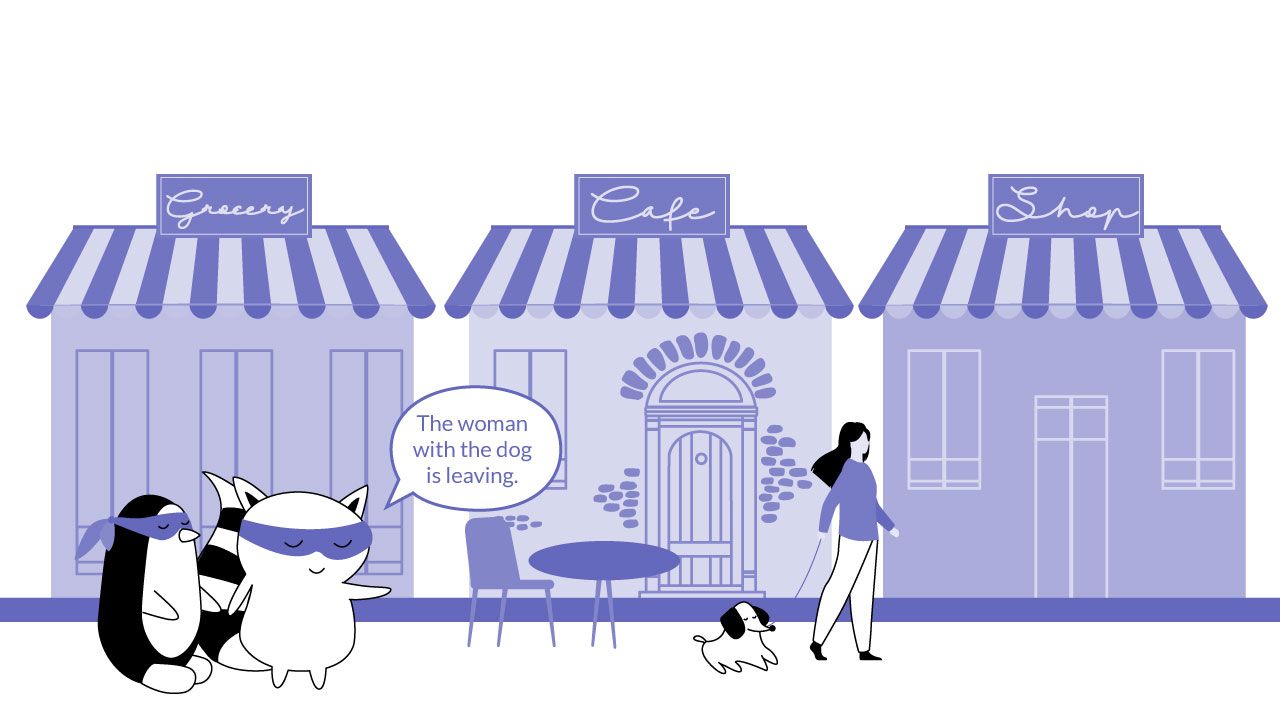
German Definite Articles
As previously stated, there are three different genders in German, and thus three different definite articles «der, die, das.» «Der» is the masculine article, «die» is the feminine article, and «das» is the neutral article.
You may be familiar with feminine and masculine articles from other languages, such as French «le» and «la,» or Spanish «el» and «la.» The German «das» is a third definite article that is used for the neuter nouns that exist in German.
When to Use Which German Article?
Unfortunately, there are no rules in German that define the gender of a noun. The majority of the words are exceptions, and in order to learn German, you must learn each noun along with its specific article.
Nevertheless, there are a few suggestions in the German language regarding nouns’ gender — let’s take a look at them, so that at least some articles are easier to remember.
Natural Gender Is Grammatical Gender
There are some German nouns that have a feminine or a masculine nature. The word «boy,» for example, describes a masculine human being, and so has the masculine article «der» in German. It would be «der Junge.»
Other examples are «die Frau» (the woman) or «der Mann» (the man). You can also see it in professions — for example, «die Ärztin» (the female doctor).
The same rule applies to animals, even though the common animal’s name is often neutral. The specific names for female or male animals have feminine or masculine articles, though. The case «das Pferd» (the horse), «die Stute» (the mare) and «der Hengst» (the stallion) is a perfect example that can show you how to use all the definite articles «der, die, das.»
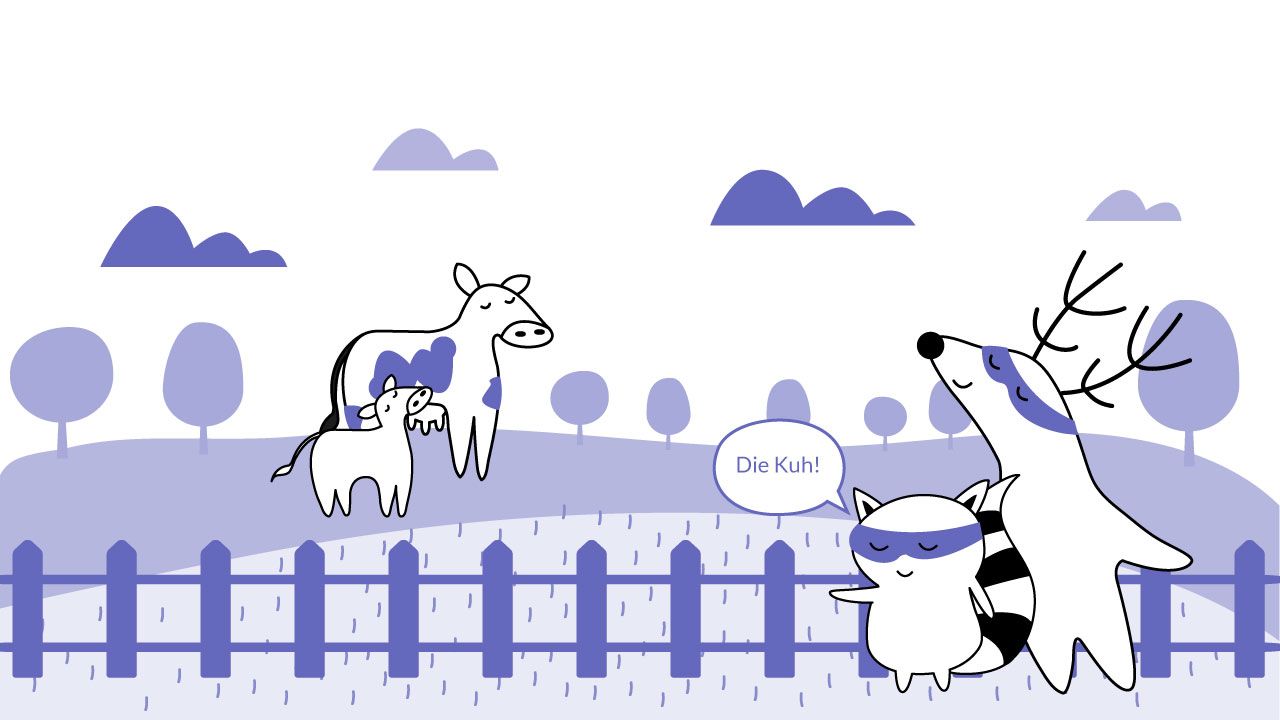
Nevertheless, we can also observe here why the German language is full of exceptions: the feminine noun «the girl» is translated as das Mädchen" in German and is used together with the neutral article. The same rule applies for «the miss,» which is «das Fräulein» in German (and not a feminine noun).
Does the Noun’s Ending Define the Gender?
Sometimes it does, but there are many exceptions. For example, while in the Spanish language a noun ending in -a is usually feminine, in German, the ending -a can be applied to all genders.
You can see it in the case with «sofa,» which is «das Sofa» in German, and so it is a neutral noun. However, «the camera» would be «die Kamera.»
Nevertheless, there are some rules that define the noun’s gender in German and can help you learn German.
Feminine Noun Endings
There are a few endings that indicate the feminine nature of a German noun.
For example, the suffix -keit, or -heit that appears in «die Traurigkeit» (the sadness), or «die Weisheit» (the wisdom).
Also, many words ending in -ei or -ung such as «die Bäckerei» (the bakery) or «die Einigung» (the agreement), are feminine in German. Furthermore, many international words ending in -ion in German and are also usually feminine. Examples are «die Institution» or «die Situation.»
Masculine Noun Endings
In German, there are also similar rules for masculine nouns. If the German word ends in -ig, or -ling, like the nouns «der Honig» (the honey) or «der Schmetterling» (the butterfly), it is typically masculine.
The same happens with German words ending in -er or on -en, like «der Computer» (the computer), or «der Regen» (the rain).

Neuter Noun Endings
For the neuter nouns, the endings -ment or -nis are often used, such as in «das Dokument» (the document), or «das Ergebnis» (the result).
It is also common to find the article «das» with words that end in -tum or -um. Two examples are «das Christentum» (the Christianity) and «das Zentrum» (the center).
The Plural Form Comes With the Feminine Article in German
What to do when you come across a plural noun in the German language?
The good news is that all German words in the plural form have the same definite article. German speakers use the feminine article «die» for plural nouns of all three genders. To give you an example, have a look at the following words:
| German singular | Translation | German plural | Translation |
|---|---|---|---|
| der Stuhl | the chair | die Stühle | the chairs |
| die Tür | the door | die Türen | the doors |
| das Auto | the car | die Autos | the cars |
You can see that all three articles turn to «die» in the plural. You also might notice that the words change a little in their plural forms. There are specific rules for that, but we will discuss that in a different post.
The Indefinite Articles in German
If you want to use an indefinite article in German, you have different articles for each gender again. The English indefinite article «a» can be «ein,» or «eine» in German. You should use «eine» for feminine nouns, while «ein» is used for masculine and neuter nouns.
The neuter noun «das Mädchen» (the girl) would be «ein Mädchen» (a girl), and also the masculine noun «der Mann» (the man) would be «ein Mann» (a man) if we’re using the word in the indefinite case. For feminine nouns such as «die Frau» (the woman), you would say «eine Frau» (a woman).
Because there is no indefinite form when speaking generally in the plural, the indefinite article only works in the singular. You can see this in the following English phrase: «A kid laughs» becomes «kids laugh» when put in the plural.

German Articles in Different Grammar Cases
Now that you know the definite articles «der, die, das» and the indefinite articles «ein, eine» we can introduce you to the German grammar case system. The German language has four grammar cases: nominative, genitive, dative, and accusative.
The cases make the articles change their original form, and you will find definite articles such as «dem» or «den» in German. Those words are not new vocabulary, but different versions of the articles you have already learned.
They are changed to indicate which grammar case a noun in the sentence is put in. We’ll go over the grammar cases in another post and show you which article you need to use in which situation. But below, you will find a short overview.
Note that in the nominative case, you will simply use the articles «der, die, das.»
Feminine Nouns in Different German Cases
With feminine nouns, the article «die» changes to «der» in the genitive and dative case. In the accusative case, it doesn’t change. Here’s an example:
- Nominative case (describes the subject of the sentence):
German
English
The woman swims.
- Genitive case (shows possession):
German
English
Der Hund der Frau schwimmt.
The woman’s dog swims.
- Dative case (used when talking about the indirect object):
German
English
Der Hund gehört der Frau.
The dog belongs to the woman.
- Accusative case (used when talking about the direct object):
German
English
The dog looks for the woman.
You might not understand how the different cases work, but we will go over that in further posts. Now, it is important that you see how the article «die» changes with the noun «Frau» (woman) in different cases. Note that it is not the noun that changes its gender, but the case that changes the article.
Masculine and Neuter Nouns in Different German Cases
We will give you the same example for masculine nouns:
- Nominative case:
German
English
The man swims.
- Genitive case:
German
English
Der Hund des Mannes schwimmt.
The man’s dog swims.
- Dative case:
German
English
Der Hund gehört dem Mann.
The dog belongs to the man.
- Accusative case:
German
English
The dog looks for the man.
You can see that the masculine article changes in all the cases other than nominative. Even for native speakers, this can be confusing sometimes.
Luckily, the neutral article changes almost in the same way as the masculine does. Look at the following example:
- Nominative case:
German
English
The kid swims.
- Genitive case:
German
English
Der Hund des Kindes schwimmt.
The kid’s dog swims.
- Dative case:
German
English
Der Hund gehört dem Kind.
The dog belongs to the kid.
- Accusative case:
German
English
The dog looks for the kid.
The neutral article changes in genitive and dative cases and does that in the same way the masculine article does, so there is no need for extra practice.
Final Thoughts
The definite and indefinite articles are probably one of the most difficult things to learn when it comes to German. It is not challenging to memorize «der, die, das» as words, but it’s important that you know when and how to use them in complete sentences.
Try not to be too hard on yourself. Even native German speakers don’t use the correct gender sometimes. When you start learning about the German case system, it will also get easier to use different articles.
We hope that we were able to awaken your interest when it comes to this topic — and also explain it clearly. To learn more about the German language, check our other posts on our blog or download the Langster app and make your language learning journey a bit more fun.
English has made dealing with articles incredibly easy – just choose the, a, or an, and you are done.
Using the right article gender proves to be one of the most challenging aspects of learning a Germanic (or even Romance) language. Instead of choosing the, a, or an, you have to consider a lot of information about the noun to determine what your article is.
If you are feeling hesitant about speaking in German, this is probably one of your greatest concerns. Don’t worry though. There is definitely a logic behind the right article.
This is not a complete guide, but it will give you most of what you need to quickly determine the most likely article gender for many nouns.
The Three Genders
German articles make it even more difficult by giving you three choices just to say the:
- der (masculine)
- die (feminine)
- das (neuter)
Once you determine the right article gender, choosing the right article is easy.
- Der, die, and das are equivalent to the
- Ein and eine are equivalent to a and an
You will also need to content with kein/keine (a negative version of a/an), but it follows the same rules as ein/eine.
What you need to remember is that the articles are essentially a part of the noun. The article used tells you a lot about the noun that it precedes.
Fortunately, you don’t have to fumble around through the articles. There are many things that you can look for in the noun that will significantly increase the odds that you pick the right article.
However, it is only fair to warn you that it is a lot of memorizing. It is much easier to memorize the different indicators than every individual word though. This is what will make it worth your time and will make it much easier to keep growing your vocabulary.
Word Endings
When you first start learning German, you have virtually no vocabulary. That makes many of the rules regarding word categories and vocabulary a little less helpful.
There is actually a much better way of knowing which of the three genders to select – the end of a word. Most articles are chosen based on the suffix (or how a word ends).
Spend a bit of time committing each gendered article list to memory. Over time, it will become second nature when you encounter an unfamiliar noun and have to guess the article.
Finally, take the time to understand how each of the noun endings sounds. When you hear them during conversation, you will start to notice how consistently used the articles are for each of the endings.
Masculine Endings
The masculine article der is often used for nouns that are more masculine. There are several endings to words that let you know that the noun should have a masculine article.
If you encounter a word that ends with the following letters, you can safely guess that the word is masculine (can be right more than 90% of the time):
| 1 | 2 | 3 |
|---|---|---|
| -ant | -ast | -er |
| -ich | -ismus | -ling |
| -ner | -or | -us |
Once you finish memorizing these, you can move on to the next set — the feminine endings.
Feminine Endings
The feminine article die is typically used with nouns that are considered feminine. It has the longest list of the three gendered articles, too.
If you encounter a noun that has any of the following ending, you will almost always be right in guessing that it is feminine:
| 1 | 2 | 3 | 4 | 5 | 6 |
|---|---|---|---|---|---|
| -ade | -e | -falt | -ie | -schaft | -tät |
| -age | -ei | -heit | -ik | -sion | -ung |
| -anz | -enz | -keit | -in | -tion | -ur |
Please note: «-e» is the least reliable of the endings on this list, but if you are completely stumped, using die is your safest bet.
You can also pair up a couple of these as you memorize the list: -sion and -tion; -heit and -keit; -anz and enz. These are similar endings that sound very similar to the English speaker’s ear. Memorizing these word pairings together will help you more quickly select die as the appropriate article during a conversation.
As a quick aside/reminder – all plural nouns use the feminine die. If you don’t catch the ending of a noun but you know that the verb is plural, you will always be correct to use the feminine article.
Neuter Endings
The smallest list to memorize is for das, and it is best to memorize it last. You will get far more nouns with feminine and masculine endings than neuter endings. Once you have those done, it will be really fast to memorize the following neuter ending indicators:
- -chen
- -ial
- -lein
- -um
There are also a few endings that tend to be neuter, but there are also some very common exceptions to these endings. Since you are likely to encounter the exceptions, we will save these ending for a different time.
A Neuter Beginning – Ge-
You probably got through the neuter endings and took a big sigh of relief. It was a short list with fairly memorable endings that will make das much easier than der and die.
However, there is one thing that you can look for in words that is frequently a dead giveaway that the correct article is das.
German words that begin with ge- are usually neuter.
If you don’t see an ending that helps you, take a quick look at the first letters. If those letters are ge-, you can guess das and be right most of the time. For example, das Gebäude (building) and das Gedicht (poem) are very common nouns you will likely use.
Occupations
Finally, we are on to something that will be far easier for you to quickly identify — once you have a better vocabulary. Both English and German speakers tend to have slightly different words for professions based on the gender of the person holding the job.
For example, English speakers have actors and actresses, businessmen and business women, and waiters and waitresses. There is a bit of a move away from this today, but not in German.
German is far more structured, and most professions are gendered. You can talk about a teacher, and it means someone who teaches, regardless of their gender. In German, a male teacher is ein Lehrer, and a female teacher eine Lehrerin.
If you know the gender of the person, you can select the right article and version of the noun without having to think about it too much.
This also applies to talking about men and women.
| Masculine | Feminine |
|---|---|
| der Mann – the man | die Frau – the woman |
| der Junge – the boy | die Mutter – the mother |
| der Vater – the father |
However, there are some very important exceptions to this (primarily for females).
Remember that list of das endings? A couple of those are considered diminutive, almost like a term of endearment.
The noun for girl is Mädchen, and if you memorized the das list, you recognize that -chen is one of the very few on that list. You would not say die Mädchen; you would say das Mädchen if you want to be correct.
Similarly, it is das Fraulein (Miss), not die Fraulein.
This is why you should memorize the endings first because those are more important than knowing the gender of the person or object.
Animals
Like professions, the gender of an animal determines which article to use.
- der Hengst – the stallion
- die Mare – the mare
- das Fohlen – the foal
This one is far more predictable as diminutives are not used for animals.
Word Categories
Finally, there are certain word categories that are gendered. If you are discussing a particular topic, then you can more safely assume the German article simply based on what you are discussing.
Try using some of these word categories in a short discussion. This can help you start to use the correct article with more certainty – and eventually greater ease.
Masculine Categories
These are probably the easiest to learn because many of them are associated with being manly. For example, it probably is not a surprise that alcoholic beverages are masculine.
- Time designates, such as months, days, and seasons
- The cardinal directions
- Alcoholic beverages (the type of beverage, not necessarily the brand)
- Mountains
- Precipitation (der Schnee [snow] and der Regen [rain])
- Rivers that aren’t in Europe, such as the Amazon
Feminine Categories
Fewer word categories are considered feminine, but there are some groups that are very large.
- Abstract ideas, such as die Freiheit (liberty) and die Gerechtigkeit (justice) – notice that many of these also end in feminine indicators
- Cardinal numbers
- The names of vessels, such as planes and ships (die Titanic)
Neuter Categories
Neuter categories are also few, but you are very likely to encounter some of these in regular conversation as well.
- Colors
- Nouns specific to technical fields, particularly science and mechanical (das Internet, das Computer)
- Chemical elements (with a very few exceptions that are masculine)
Many words borrowed from other languages fall into the neuter category as well. In the early days though, you probably aren’t going to know which words are borrowed and which are native to German. This rule will help you later as you get a stronger feel for what is a native word.
Don’t Panic
Using the wrong gender will make it blatantly obvious that you are still learning the language – and that is perfectly fine. There is a good reason why you need a guide to get started for German articles.
It doesn’t matter how quickly someone else you know is learning the articles. This isn’t a race. Taking more time to really learn and memorize these tips can make you a better speaker in the long run.
You will encounter the occasional word that does not follow these guidelines. Try to commit it to memory for the future. More than 75% of the time though, you will get it right by following these rules.
And if you don’t, it’s alright. German speakers understand that it isn’t easy for you as an English speaker, and they are more than willing to help you out.
German articles can give language learners a headache. They’re particularly tricky because they have to reflect gender, case and number of the noun, which isn’t the case in English. Other languages with cases modify the noun to indicate case and omit an article altogether. Learning German articles means declinating definite and indefinite articles and knowing the gender of every single noun you want to use, a seemingly daunting task. But we’ll show you a shortcut!
Quick overview: What are German articles?
German articles are the equivalent of “the” and “a” in English in reference to nouns. However, a major difference between the two languages is that each article has to agree in gender, case and number with the noun.
English has articles, but not cases; German has both. The four German cases are nominative, genitive, dative and accusative. The gender of a noun can be masculine, feminine or neuter. The number indicates if a noun is singular or plural.
- German from Germany, Austria and Switzerland: Key vocabulary differences
The definite articles in German
The definite article refers to specific, countable nouns. In German, the definite articles are der, die, das for masculine, feminine and neuter, which in English are all “the”.
| CASE | MASCULINE | FEMININE | NEUTER | PLURAL |
| Nominative | Der Mann | Die Frau | Das Haus | Die Männer / Frauen / Häuser |
| Genitive | Des Mannes | Der Frau | Des Hauses | Der Männer / Frauen / Häuser |
| Dative | Dem Mann | Der Frau | Dem Haus | Den Männern / Frauen / Häusern |
| Accusative | Den Mann | Die Frau | Das Haus | Die Männer / Frauen / Häuser |
The indefinite articles in German
The indefinite article is used for non-specific nouns, and in the plural, for an uncount number. English uses “a” and “an” as well as “some” in the plural.
| CASE | MASCULINE | FEMININE | NEUTER | PLURAL |
| Nominative | Ein Mann | Eine Frau | Ein Haus | Einige Männer / Frauen / Häuser |
| Genitive | Eines Mannes | Einer Frau | Eines Hauses | Einiger Männer / Frauen / Häuser |
| Dative | Einem Mann | Einer Frau | Einem Haus | Einigen Männern / Frauen / Häusern |
| Accusative | Einen Mann | Eine Frau | Ein Haus | Einige Männer / Frauen / Häuser |
10 super literal German words
Tricks for pairing German articles with nouns correctly
When you’re used to articles without case and gender as in English or even a language without articles, having to remember so many things to get German articles right can appear as the hardest part of learning the language.
However, there are arbitrary rules for the gender of some words, allowing you to infer their gender from their ending. We’ll give you an overview of these German nouns, which allows you to always use the correct article.
Der
There are a few word endings which indicate a noun is masculine and therefore requires the article “der”: -ant, – or, -ich, -ling, -us, -ist.
| -ant | -or | -ich | -ling | -ismus | -ist |
| Der Praktikant Der Konsonant Der Ministrant |
Der Doktor Der Motor Der Humor |
Der Teppich Der Abstrich Der Rettich Der Vergleich |
Der Zwilling Der Häftling Der Säugling Der Winzling Der Frühling |
Der Tourismus Der Optimismus Der Kapitalismus |
Der Polizist Der Pianist Der Spezialist Der Internist |
The best websites to take an online German class
Die
The word endings -keit, -ion, -heit, -enz, -tät and -ung indicate a feminine noun and need the female article “die”.
| -keit | -ion | -heit | -enz | -tät | -ung |
| Die Geschwindigkeit Die Gefälligkeit Die Häufigkeit |
Die Station Die Nation Die Situation |
Die Seltenheit Die Schönheit Die Feigheit |
Die Tendenz Die Präsenz Die Differenz |
Die Spezialität Die Normalität Die Solidarität |
Die Handlung Die Einladung Die Anleitung |
15 German expressions you won’t find in your textbook
Das
The endings -chen, -ium, -tum, -lein, -o, -ment and -is indicate a neuter noun and agree with the neuter article “das”.
| -chen | -ium / -tum | -lein | -o | -ment | -is |
| Das Händchen Das Ständchen Das Zeichen Das Kaninchen |
Das Aquarium Das Ministerium Das Sammelsurium Das Ultimatum Das Brauchtum Das Votum |
Das Fräulein Das Büchlein Das Blümlein Das Verslein |
Das Tempo Das Video Das Solo Das Konto Das Studio |
Das Kompliment Das Medikament Das Instrument Das Dokument |
Das Zeugnis Das Hindernis Das Erlebnis Das Geheimnis |
The most common spoken words in German
More tips how to remember articles in German
- When learning a new noun, always learn the gender with it by remembering the definite article. The added benefit is that you’ll not only use the correct article, you’ll make it much easier to properly pair adjectives as well.
- Roughly two thirds of German words with one syllable are masculine. When in doubt, guess masculine with these short words.
- A majority of singular nouns ending in -er are masculine, but there are exceptions, such as “Die Mutter” (the mother). Keep in mind that -er can also form the plural of many words.
- A large majority of nouns ending in -e are feminine.
- Some word endings are misleading: -nd seems to be primarily masculine, as in “Der Mond”, “Der Mund”, “Der Hund”, but exceptions are “Die Hand” or “Das Band”.
- The beginning of a word can be an indicator as well: Ge- can often be a neuter word, as in “Das Gesetz” or “Das Gespräch”, but again, der are exceptions: “Die Geschichte” or “Die Gebärde”.
Apart from articles, how else are German and English different? Find out the 7 major differences between English and German grammar!


